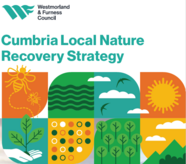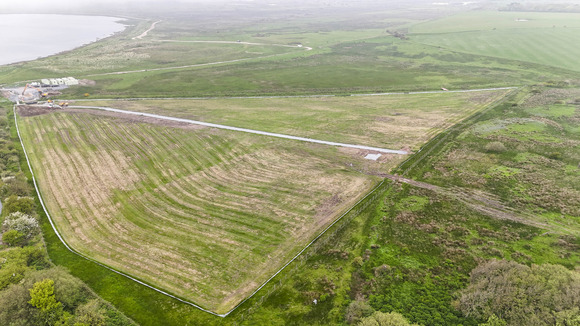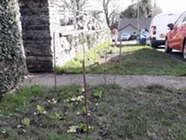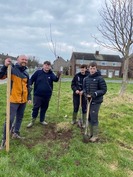
Thank you to everyone who took the time to complete and share our recent survey which looked to seek people's thoughts on all things nature in Cumbria.
People were invited to take part, whether they live, work or visit the area, love watching wildlife, enjoy an epic day exploring the fells and lakes, or are more at home by the coast.
We're developing a Local Nature Recovery Strategy (LNRS) for Cumbria with supporting authorities Cumberland Council, Lake District National Park, Yorkshire Dales National Park and Natural England.
We've received over 760 responses and will now spend time analysing your feedback to see what's important to you, and use your priorities and ideas to help shape and inform our plans.
|
Share your feedback on our draft priorities
The LNRS Team has been focusing on the necessary work to establish the LNRS priorities for nature recovery in Cumbria. The LNRS priorities establish what the strategy is trying to achieve over the next three to ten years to aid in Cumbria’s nature recovery.
Since January, the project's habitat-themed groups have been reviewing various strategies, policies and data, extracting their priorities (or objectives), and compiling a long list of existing nature recovery priorities for Cumbria.
The LNRS Team has since hosted six workshops during March to bring each group together, establish a long-term vision for each habitat theme, and identify a small number of targeted priorities using the long list created from the strategy review work.
After a review, we now have an initial list of 26 draft priorities for habitats in Cumbria, which can be viewed on the LNRS website.
If you have any comments on these priorities and would like to provide feedback, email Cumbria.LNRS@westmorlandandfurness.gov.uk.
Works are firmly underway to construct our new 2MW solar farm site at Sandscale Park in Barrow.
 We are constructing a new 2MW solar farm site on council-owned land at Sandscale Park in Barrow which will generate green electricity to offset the council's carbon emissions.
This exciting renewable energy project got underway in April and is due to be completed in the autumn. It marks a significant milestone for the council and is the first of more schemes to come as part of our wider decarbonisation programme of work.
This is expected to result in annual savings of around 507 tonnes of carbon dioxide equivalent which would provide enough electricity to power the council’s five leisure centres or approximately 730 homes per year (based upon average UK households).
Works to upgrade access to the site have already been completed and this next stage of the project will see main works get underway including the installation of the panels and mounting structure, and the laying of electrical cables.
Part of this development also includes Biodiversity Enhancement Plans which look at ways to increase opportunities for pollinators, manage grassland sheep grazing levels, retain bird nesting habitat, and enhance woodland.
Watch this space for further updates as the project progresses!

As a council, we are committed to protecting and enhancing biodiversity and nature, and are committed to working collaboratively with town and parish councils, communities and other partner organisations in tackling the biodiversity crisis in a just and fair manner.
Did you know?
25% of the UK’s mammal species are now under threat of extinction, 97% of our wildflower meadows have been lost since 1930 and 41% of species have decreased in abundance since 1970.
|
A biodiversity toolkit is now available!
To encourage and inspire support for our biodiversity, we have created a toolkit for anyone who is already doing great work to support biodiversity, would like to know more about what options are available, and what benefits they would bring for both our environment and communities.
The document looks at the ways we can work collaboratively with and support town and parish councils, community groups and partner organisations, and share some ideas and examples of biodiversity features.
There are also some handy tips and information, from how to go about starting a biodiversity project to a list of biodiversity features such as bee hotels, bird boxes and tree planting.
We hope to encourage and inspire everyone to do more for biodiversity so that together we can help make a difference for our environment and communities.
Take a look at our toolkit.
Caring for our roadside verges
The sides of Westmorland and Furness’ roads are home to hundreds of species of wild plants and animals.
Recognised as a valuable resource for biodiversity, roadside verges can also bring great pleasure and delight, helping us connect with nature on our journeys wherever we go and acting as important corridors to connect one habitat to another for species.
We've created a leaflet which explains how by working together, we can balance the necessary road safety and maintenance requirements, with sensitive ongoing management to help biodiversity on our roadside verges thrive.
Read our Roadside Verges leaflet.

Working together in Kendal
We've been working closely with the Fellside Forum in Kendal to make biodiversity improvements at the top of Greenside on the lane to the golf course.
After speaking to the group, the Council agreed to only mow the verge immediately next to the tarmac so that a greater range of plant species can thrive and encourage more insects and pollinators.
To help this along, the Fellside Forum applied to the Council who awarded the project a small grant to buy some plants and seeds.
A group of neighbours, with help from Kendal Conservation Volunteers at Dog Kennel Wood and Fairoak Trust residents, then planted and seeded the verge.
We look forward to seeing what different types of insects the plants and wildflowers attract!
|

In April, we held an event with the community at Park View Playing Fields in Barrow to celebrate the creation of a new community forest.
Working with Raise: Cumbria Community Forest, The Brathay Trust and The Knotted Project, over 4,000 trees and shrubs have been planted, showing a significant commitment to biodiversity and climate action.
The new forest will become a haven for wildlife, improve air quality and help combat climate change. It will also help to bring people closer to nature, creating a space for recreation and education, and fostering stronger community ties.
|
Last year, we confirmed 21 partnerships from across Westmorland and Furness were to receive a share of almost £900,000 to help tackle climate action and support nature recovery.
Here are some examples of that funding being used so far:
PLACE - Paths to Leadership: Active Community Engagement
Cumbria Development Education Centre (CDEC) is helping young people to lead change in their communities with a project which aims to engage young people in a range of activities connecting them with each other and their ‘place’. The project began in January this year and will run for 15 months, empowering young people to 'think global, act local'.
Windermere Science Festivals CIC
Windermere Science Festival will use the funding towards their annual festival for the next three years. This year's festival, which took place last month, had their best line up to date with a range of activities from inspiring talks and engaging exhibitions, to cutting edge research and explosive family fun.

We are pleased to be working with Cumbria Wildlife Trust to further create flower-rich, pollinator-friendly habitats in community green spaces as part of the Trust’s “Get Cumbria Buzzing, Not Buffering” initiative, funded by Fibrus Broadband.
This collaborative project aims to engage communities across Cumbria, encouraging them to take positive action for pollinators in their local areas.
By 2025, through working with local communities and landowners, the partnership will have helped create or restore 15 valuable sites for pollinators, ensuring that they’re managed correctly and continue to be wildlife havens long into the future.
During the three-year project, the project will also run community planting days, as well as pollinator identification and training sessions. In addition, 1,500 packs of native Cumbrian wildflower seeds will be given out across the county.
The first community planting day has already taken place at Town View Fields in Kendal, where 20 volunteers joined in with planting 1,200 plugs.
Read the full story on Cumbria Wildlife Trust's website.
|

We were pleased to support the Ambleside and Grasmere ‘Big Switch Off’ event that took place in February by turning off streetlights in the area.
Residents, businesses and visitors were also encouraged to join in by turning off their lights overnight, providing an opportunity to appreciate the impact on stargazing.
This annual collaborative initiative, led by Friends of the Lake District as part of their Dark Skies project, aims to showcase the beauty of the night sky while promoting electricity conservation.
Although the weather was wet, it was still a great opportunity to truly observe nature and appreciate our local surroundings without the impact of light pollution.
|

We've received a funding grant of £330,718 from Phase 2 of Sport England’s Swimming Pool Support Fund to make Appleby and Penrith Leisure Centres more energy efficient and sustainable.
The funding follows the successful bid to Phase 1 of the Sport England Fund, which saw £235,000 awarded to Barrow Park Leisure Centre to help with rising energy, maintenance and chemical costs.
This new funding will see a number of energy saving improvements made to Appleby and Penrith leisure centres including the installation of solar panels, pipework insulation and triple glazing.
|
The Planting for Pollinators Project aims to help reverse pollinator decline in Cumbria by creating a mosaic of habitats, including species-rich grassland, hedges, scrub, deadwood, sunny banks, glades and flower-rich gardens to facilitate movement and provide food, shelter and nesting sites for pollinators.
Thanks to funding from Westmorland and Furness Council, pollinator friendly works are being carried out in the Barrow and South Lakeland areas, creating pollinator friendly habitats in community spaces.

Lesh Lane
This Spring, we carried out tree and shrub planting at Lesh Lane in Barrow. The trees and shrubs were all selected by students from South Cumbria Pupil Referral Unit based at Newbridge House in Newbarns.
Thanks to the help and hard work of students from the Pupil Referral Unit as well as members of the public and representatives from ‘Love Barrow Families’, ‘Furness Multi-Cultural Society’ and Mind, the planting was completed ahead of schedule.
The types of shrubs planted include Guelder Rose, Elderberry, Dogrose, Hawthorn and Spindle. These species are all native to the UK and locally occurring in and around Barrow. They were chosen especially for their pollinator suitability, with some such as Cherry having amazing blossoms, providing important pollen and nectar supplies, and others are great food plants for many caterpillars of our butterflies and moths.
The trees planted include Field Maple, Wild Cherry, Sessile Oak, Crab Apple and Grey Willow. The oak trees are known to support an incredible amount of British wildlife, with the Elderberry, Wild Cherry and Crab Apple providing edible fruits, hopefully providing an opportunity for communities to interact directly with the trees through harvesting the fruit and creating lovely crumbles and syrups!
|

Blake Street and Holker Street
In March, we held a planting day at Blake Street and Holker Street in Barrow, involving a planting session with students from St James' Primary School and local residents.
From children's old wellies to empty ice cream tubs and finished baked beans cans, those who attended were able to make their own mini planter with local wildflowers and learn about helping pollinators in the garden or on their window sill, and see the streets' newly restored pollinator-friendly planters.
They also got to take a plant home with them!
|
Biggar Bank

As part of the Planting for Pollinators Project for Biggar Bank, The Round House café located on the bank has worked with students from George Hastwell School to create some planters for all visitors to enjoy.
Speaking about their day, George Hastwell School said:
"Thank you for the opportunity to give back to the community. We look forward to seeing how these plants grow and how the wildlife thrive."
|

In March, the waste contractor Renewi launched a new 'Baa-ttery' campaign to encourage people to recycle the 3.2 million batteries discarded in Cumbria each year - the equivalent to the weight of over 3650 Herdwick sheep!
Renewi has partnered with Valpak and the campaign is supported by Westmorland & Furness Council, Cumberland Council and Cumbria Fire & Rescue Service.
The campaign sees a new 'Superewe' character to raise public awareness and represent the mascot for this and future campaigns. The mascot has been placed on all new Valpak battery boxes supplied to all 269 primary schools across Cumbria.
When the boxes are full, they will be collected for free, and a replacement provided. Book tokens will be awarded to the schools which collect the most unwanted batteries before the school summer holidays.
The ‘Baa-ttery’ campaign has since been shortlisted for Let's Recycle's 'Campaign of the Year'.
Did you know?
Batteries, commonly found in various household items including toys, phones, electronic equipment and vapes, should never be disposed of in regular waste or recycling bins.
When damaged during the transportation or treatment process, they have the potential to explode or ignite, which can lead to fires and pose serious risks to personal safety.
There are designated household battery banks at all of our household waste recycling centres (HWRCs). Find your nearest HWRC.
|

In March, we held a take-back event with a difference.
For one week only, people could bring back unwanted aids for daily living to Penrith Town Hall where they were then collected, cleaned and sanitised for reuse.
A total of 63 items, such as commodes, toilet frames, bed levers and shower chairs, were returned with a total weight of 352kg. Estimated carbon savings as a result of this take-back event are 620kg.
These events not only create an easy way for people to return unwanted equipment and save carbon but importantly help address a shortage of equipment and support people to stay active and independent in their own homes.
|
Shap
In Shap, we have recently engaged with local residents and the town council to discuss the progress of our natural flood management (NFM) scheme aimed at enhancing the village's resilience.
Working collaboratively with local residents and the town council ensures that our plans are well-informed by community insights and environmental data.
We are now finalising our latest model which will play a crucial role in developing our business case for funding later this year.
Walney Island: West shore park
On Walney Island, our team is actively working with contractors to address the damage to temporary defences caused by the spring high tide.
The recent completion of radar analysis provides us with important data which is now under review to guide our future actions.
Grange-Over-Sands: Windermere Road / Lindale Road
In Grange-Over-Sands, we're working on a project at Windermere Road and Lindale Road which aims to enhance the area's flood resilience infrastructure.
The initial phase of the works has been successfully completed providing us with a clear understanding of the existing ground conditions.
The project is now progressing towards Phase 2 of the works with a tender being drafted for a design and build contract.
Funded by the UK Government and Westmorland and Furness Council, the Westmorland and Furness Green Enterprise Hub project is a dynamic initiative led by Cumbria Action for Sustainability (CAfS).
The initiative is dedicated to supporting local organisations on their journey towards decarbonisation and sustainability.
The hub is a one-stop shop for both commercial and not-for-profits, offering expert advice, training and events, grants, and a vibrant network of partners and collaborators.
One of the project's delivery partners, Art Gene, has worked with five organisations in Barrow to make short films showcasing how they are trying to reduce their carbon footprint:
Full of Noises - hear Glenn Boutler, Artistic Director for Full of Noises, describe how a building retrofit allowed the Full of Noises charity to introduce innovative decarbonisation measures. Its air source heat pump was funded by the ERDF as part of Low Carbon Barrow.
Stollers Ltd - hear Lee Stoller, Director of Stollers the furniture store, talk about the carbon saving initiatives introduced across the business.
Barrow Sea Cadets - hear Lieutenant Niyall Phillips of Barrow Sea Cadets talk through the benefits of their solar panel and battery setup, installed with the help of Low Carbon Barrow, funded by the ERDF.
Dandy's - hear Jeff Dandy, owner of Dandy's furniture store, describe environmental measures introduced to the store and his aspirations for the future.
Furness Media - hear Guy Ritch, Director of Furness Media, introduce the decarbonisation measures introduced by the company, partly supported by Low Carbon Barrow, funded by the ERDF.
Let it Bloom June!

No Mow May is over, what's next?
Now the growth season moves into June, things don’t have to get messy or overgrown, but you can still maintain a space for your local wildlife.
By not mowing or reducing the frequency in which you mow, you've been helping to rekindle your wildflowers and in turn thrown your pollinators a much needed lifeline.
You might be concerned that if you let things grow any higher your mower may no longer be able to do its job. If your grassy growth has got away from you, don’t panic. Not all mowers can cope with tall vegetation but most can if you mow in two stages.
Firstly, check your lawn for wildlife and then set the blades as high as possible.
As you mow, progress gradually towards sanctuary areas such as uncut grass strips at boundaries. This leaves an escape route for wildlife.
For more information on how to manage your garden going forward, visit Plantlife's website.
|
Great Big Green Week is back!

We are once again supporting The Great Big Green Week from 8-16 June.
This year's theme is 'Let's swap together for good' which encourages people to reduce waste and encourage the reuse and recycling of goods.
Great Big Green Week is the UK’s biggest-ever celebration of community action to tackle climate change and protect nature.
Working collaboratively with Cumbria Action for Sustainability, we have provided funding to support grants of up to £300 for not-for-profit groups to help them hold events in their local area across Westmorland and Furness.
To see what events are taking place near you or to have your event added to the list, visit the Zero Carbon Cumbria website.
|
Clean Air Day - 20 June

The annual campaign sees schools, hospitals, workplaces and communities across the UK run events and campaigns to inspire people to take simple steps to protect their and their families’ health from air pollution.
Air pollution affects you from your first breath to your last and causes up to 36,000 deaths in the UK every year. Clean air is essential for our health, and the co-benefits of clean air measures are good for our wellbeing as well as the planet.
The good news is that our air pollution crisis is solvable and there are simple steps we can all take to improve the quality of the air we breathe and cut down on the pollution we emit.
We can all help by:
-
Changing the way we travel – incorporating more walking, cycling and public transport is a great way to reduce our impact on the environment, improve our health and fitness, all while saving some money.
-
Not idling our engines – idling is a significant contributor to local air pollution but switching off our engine when stationary, for example when waiting at traffic lights, can help.
-
Going electric. Consider joining a growing number of electric vehicle owners next time you need to change your car or van. A map of electric vehicle charging locations can be found on our website.
Visit the Clean Air Day website for more information.
|
|